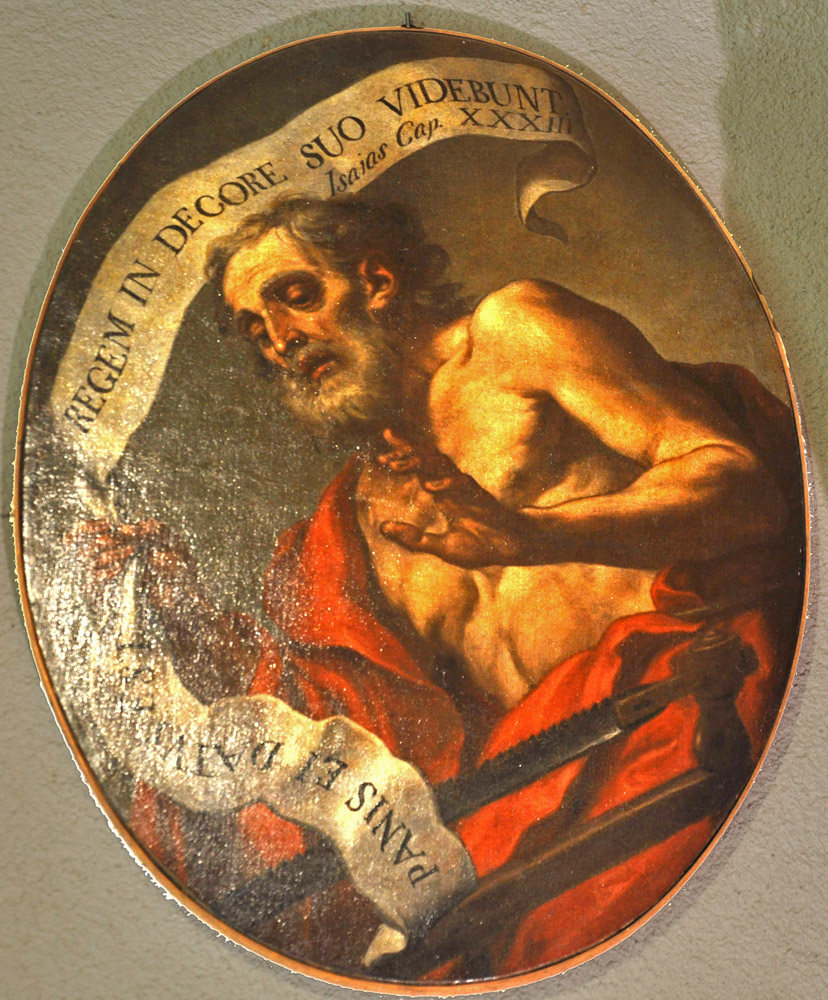In a "Jesse Tree" image the scroll may bear the words from Isaiah 11:10: in die illa radix Iesse, qui stat in signum populorum, ipsum gentes deprecabuntur, et erit sepulchrum eius gloriosum, "In that day the root of Jesse, who standeth for an ensign of the people, him the Gentiles shall beseech, and his sepulchre shall be glorious" (example).
Isaiah can also be represented at the Adoration of the Magi (example), where the verse cited can be Isaiah 60:14 (Et adorabunt vestigia pedum tuorum omnes qui detrahebant tibi, "And those who used to slander you will adore the footprints of your feet") or 60:6 (Inundatio camelorum operiet te, dromedarii madian et epha; omnes de Saba venient, aurum et thus deferentes, "The multitude of camels shall cover thee, the dromedaries of Madian and Epha: all they from Saba shall come, bringing gold and frankincense").
In the Church of St. Clement in Rome Isaiah holds a scroll reading vidi Dominum sedentem super solium, "I saw the Lord sitting on a throne," as he stands in the frame of an allegorical mosaic where Christ's "throne" is the cross (Isaiah's portrait, whole mosaic).
In one mosaic in Ravenna, Moses and Isaiah are in the lower register representing the Law and the Prophets while Saints Mark and Matthew in the upper register represent the New Testament.
In a third-century letter Origen mentioned a tradition that Jewish leaders had executed Isaiah by sawing him in half. The same assertion is made in the third-century Ascension of Isaiah.1 This idea is illustrated in this miniature from the 13th century. A bucksaw is used as his attribute in the second picture at right. According to the Mirror of Salvation (62) "Isaiah's enemies cut him in two and in so doing fitly foreshadow the death of Christ insofar as the enemies of Christ divide him in two, separating his soul from his body by means of the cross."
Another feature sometimes seen in images of Isaiah is a hot coal (example), referring to Isaiah 6:6-7, where a seraph touches his lips with an ember from the altar of the Lord and says, "now that this has touched your lips your wickedness is removed."
Prepared in 2014 by Richard Stracke, Emeritus Professor of English, Augusta University.
HOME PAGE

Isaiah standing beside a Nativity scene (See the description page)

With a bucksaw as his attribute (See the description page)
ATTRIBUTE
- Scroll, book, or banderole with a quotation from his prophecies
- Bucksaw
MORE IMAGES
- 4th century: A dome painting from the Bagawat Necropolis, Egypt.
- Circa 1291: As in the San Clemente arch mentioned above, Isaiah and Jeremiah are presented on the triumphal arch as examples of the fruitfulness of martyrdom.
- 1475: The Isaiah panel in the rood screen at Santa Maria Gloriosa dei Frari, Venice.
- 1503: Altarpiece in Salamanca
- Early 17th century: In Christoph Murer's engraving Isaiah presents an allegorical rendering of his "All you that thirst, come to the waters" (Isaiah 55:1).
DATES
- Isaiah lived in the 8th century B.C. The vision of the hot coal occurred in "the year King Uzziah died," 742 B.C.
BIOGRAPHY
ALSO SEE
NOTES
1 The Ascension of Isaiah, 5:1-14; Origen, "A Letter to Origen from Africanus About the History of Susanna," in Schaff, IV, 388. Isaiah is probably the person indicated in the second phrase of Hebrews 11:37, "They were stoned, they were cut asunder, they were tempted, they were put to death by the sword, they wandered about in sheepskins…" The 13th-century Book of the Bee (XXXII) says that Isaiah was murdered by Manasseh, the son of King Hezekiah, with a wooden saw.